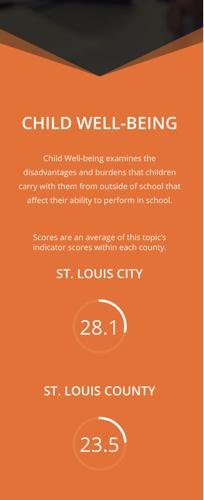How are we doing? In terms of racial equity, that is. That question was often asked a couple of months ago around the 5-year anniversary of the onset of the Ferguson unrest. Now the Regional Equity Indicators Dashboard, STLEquity.org, strives to provide data sets to answer that question and track future progress over time.
The dashboard, or graphical user interface, was created as a response to the Ferguson Commission’s Signature Calls to Action for a way to quantify the state of racial equity in the region. It’s an expansion of the City of St. Louis’s Equity Indicators Baseline Report released in late 2018.
It consists of 72 indicators organized into three main themes drawn from the Ferguson Commission report – Youth at the Center, Opportunity to Thrive, and Justice for All. They measure quality-of-life factors such as child wellbeing, education quality, educational attainment, financial empowerment, health and safety, neighborhoods, policing, court reform, and civic engagement.
The dashboard currently measures indicators for the City of St. Louis and St. Louis, St. Charles and St. Clair (Illinois) counties.
“I believe having the information in this easy-to-read electronic format may help area residents, politicians, and the business establishment to understand the disparities in this region,” said Denise R Hooks-Anderson, MD, associate professor of
Family and Community Medicine at SLUCare and the medical accuracy editor of The St. Louis American.
“Unnecessary hospitalizations from lack of access to care, poor teacher attendance, and high infant mortality rates are all problems that affect us all. Until the St. Louis community begins to consider itself as one — and not all of these fragmented municipalities — we will continue to see these disparities, which do contribute to the overall financial health of this area as well as to public safety.”
Each indicator is calculated through a ratio between the outcomes for black and white residents that is converted to scores on a scale of 1 to 100, with 100 representing greater racial equity. University of Missouri’s Community Innovation and Action Center (CIAC) took the lead research role in collecting and analyzing the data from various publicly available sources, determining indicator scores and developing the indicator analyses.
Like the Ferguson Commission report, which was published as a living document, this is a work in progress.
“We can strengthen the Regional Equity Indicators Dashboard by working together to fill in missing data and by partnering to sustain this important community resource,” said Paul Evensen, CIAC director.
The project is a collaboration of CIAC, United Way of Greater St. Louis, the City of St. Louis, Forward Through Ferguson and St. Louis Regional Chamber, following a model developed by the City University of New York’s Institute for State and Local Governance.
David Dwight IV, lead strategy catalyst of Forward Through Ferguson (which carries forward the work of the Ferguson Commission), said the project is “a starting point to build our muscle for the transparency, accountability, and aligned regional effort needed to advance the community vision of the Ferguson Commission report. We hope more organizations and municipalities will intentionally measure racial equity and join the collaborative.”
Jason Q. Purnell, associate professor at the Brown School at Washington University who leads Health Equity Works, was the lead researcher in “For the Sake of All,” the landmark 2013 report on racial disparities in health and well being in the St. Louis region. In many ways, that 2013 report was the canary in the coal mine of the Ferguson unrest, which followed almost exactly one year later.
Purnell said that many of these disparities have been known by many people in the region at least since the publication of “For the Sake of All,” and obviously many who were woke by that report or Ferguson have not been moved to action. But, he said, more and new data will reach new people, wake some of them up, and move some of them to action.
“There are people who genuinely don’t know about these issues and are pretty disturbed when they learn. I’ve learned that that’s who we need to be talking to,” Purnell said.
“We’re never going to change the hardened opposition. It’s the broad middle where we might see movement. And the emphasis is definitely on the might.”
For more information, visit STLEquity.org.













(0) comments
Welcome to the discussion.
Log In
Keep it Clean. Please avoid obscene, vulgar, lewd, racist or sexually-oriented language.
PLEASE TURN OFF YOUR CAPS LOCK.
Don't Threaten. Threats of harming another person will not be tolerated.
Be Truthful. Don't knowingly lie about anyone or anything.
Be Nice. No racism, sexism or any sort of -ism that is degrading to another person.
Be Proactive. Use the 'Report' link on each comment to let us know of abusive posts.
Share with Us. We'd love to hear eyewitness accounts, the history behind an article.